Thyroid cartilages - Study guides, Class notes & Summaries
Looking for the best study guides, study notes and summaries about Thyroid cartilages? On this page you'll find 460 study documents about Thyroid cartilages.
Page 2 out of 460 results
Sort by
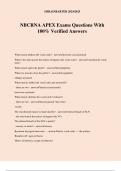
-
NBCRNA APEX Exams Questions With 100% Verified Answer
- Exam (elaborations) • 123 pages • 2024
-
- $11.49
- + learn more
NBCRNA APEX Exams Questions With 100% Verified Answers What muscle abducts the vocal cords? - answerposterior cricoarytenoid What is the only muscle that tenses (elongates) the vocal cords? - answercricothyroid "cords tense" What muscle opens the glottis? - answerthyroepiglottic What two muscles close the glottis? - answeraryepiglottic oblique arytenoid What muscles adduct the vocal cords and arytenoids? - there are two - answerlateral cricoarytenoid transverse arytenoid What muscle...
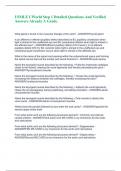
-
SMLE UWorld Step 1 Detailed Questions And Verified Answers Already A Grade.
- Exam (elaborations) • 141 pages • 2024
-
- $19.49
- + learn more
USMLE UWorld Step 1 Detailed Questions And Verified Answers Already A Grade. What gland is found in the muscular triangle of the neck? - ANSWERThyroid gland Is an afferent or efferent pupillary defect described as B/L pupillary constriction when light is shined in the unaffected eye and B/L paradoxical dilation when light is shined in the affected eye? - ANSWERAfferent pupillary defect (CN II lesion); in an efferent pupillary defect (CN III), B/L constrict when light is shined in the u...

-
USMLE STEP 1 EXAM TEST BANK QUESTIONS | WITH 100% CORRECT ANSWERS | LATEST UPDATE | GRADED A+
- Exam (elaborations) • 247 pages • 2024
- Available in package deal
-
- $13.49
- + learn more
What gland is found in the muscular triangle of the neck? ANS- Thyroid gland Is an afferent or efferent pupillary defect described as B/L pupillary constriction when light is shined in the unaffected eye and B/L paradoxical dilation when light is shined in the affected eye? ANS- Afferent pupillary defect (CN II lesion); in an efferent pupillary defect (CN III), B/L constrict when light is shined in the unaffected eye and consentual pupil constriction occurs when light is shined in the...
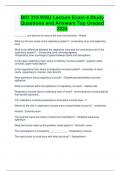
-
BIO 315 WSU Lecture Exam 4 Study Questions and Answers Top Graded 2024
- Exam (elaborations) • 14 pages • 2024
-
Available in package deal
-
- $15.99
- + learn more
_________ are terminal air sacs at the end of bronchioles - Alveoli What are the two zones of the respiratory system? - conducting zone and respiratory zone What is the difference between the respiratory zone and the conducting zone in the respiratory system? - -Conducting zone: aire passageway -Respiratory zone: exchange of gases between blood and atmosphere In the upper respiratory tract, where is olfactory mucosa located? - superior nasal conchae, upper nasal septum In the respir...
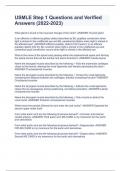
-
USMLE Step 1 Questions and Verified Answers (2022-2023)
- Exam (elaborations) • 141 pages • 2023
-
Available in package deal
-
- $12.99
- + learn more
USMLE Step 1 Questions and Verified Answers (2022-2023) USMLE Step 1 Questions and Verified Answers (2022-2023) USMLE Step 1 Questions and Verified Answers (2022-2023) What gland is found in the muscular triangle of the neck? -ANSWER Thyroid gland Is an afferent or efferent pupillary defect described as B/L pupillary constriction when light is shined in the unaffected eye and B/L paradoxical dilation when light is shined in the affected eye? -ANSWER Afferent pupillary defect (CN II lesion);...
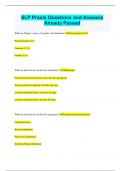
-
SLP Praxis Questions and Answers Already Passed
- Exam (elaborations) • 185 pages • 2024
- Available in package deal
-
- $12.49
- + learn more
SLP Praxis Questions and Answers Already Passed What are Piaget's stages of cognitive development? Sensorimotor (0-2) Preoperational (2-7) Concrete (7-11) Formal (11+) What are the muscles involved in inspiration? Diaphragm External intercostal muscles: raise the ribs up and out Serrates posterior superior: elevates rib cage Levator costarium brevis: elevates rib cage Levator costarum logies: elevates rib cage What are the muscles involved in expiration? Internal intercostal muscles Latissimu...
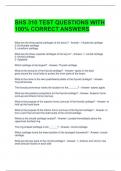
-
SHS 310 TEST QUESTIONS WITH 100% CORRECT ANSWERS
- Exam (elaborations) • 4 pages • 2024
-
Available in package deal
-
- $12.59
- + learn more
SHS 310 TEST QUESTIONS WITH 100% CORRECT ANSWERS What are the three paired cartilages of the larynx? - Answer- 1-Arytenoid cartilage 2-Corniculate cartilage 3- cuneiform cartilage What are the three unpaired cartilages of the larynx? - Answer- 1- cricoid cartilage 2- thyroid cartilage 3- Epiglottis Which cartilage is the largest? - Answer- Thyroid cartilage What is the structure of the thyroid cartilage? - Answer- opens in the back goes around the vocal folds to protect the inn...
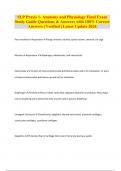
-
SLP Praxis 1- Anatomy and Physiology Final Exam Study Guide Questions & Answers with 100% Correct Answers | Verified | Latest Update 2024
- Exam (elaborations) • 14 pages • 2024
- Available in package deal
-
- $13.48
- + learn more
Parts involved in Respiration lungs, bronchi, trachea, spinal column, sternum, rib cage Muscles of Respiration diaphragm, Abdominals, and Intercostals Intercostals 11 pairs of internal intercostals pull thorax down and in for exhalation, 11 pairs of external intercostals pull thorax up and out for inhalation Diaphragm muscle at floor of chest cavity that separates abdomen and thorax. Plays major role in breathing and is almost the only muscle used in passive breathing. Laryngeal Structures...
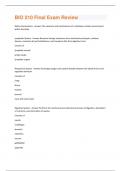
-
BIO 210 Final Exam Review Questions And Answers Rated A+ New Update Assured Satisfaction
- Exam (elaborations) • 21 pages • 2024
- Available in package deal
-
- $8.49
- + learn more
Define Homeostasis - Answer-The existence and maintenance of a relatively constant environment within the body. Lymphatic System - Answer-Removes foreign substances from the blood and lymph, combats disease, maintains tissue fluid balance, and transports fats from digestive tract. Consist of: lymphatic vessels lymph nodes lymphatic organs Respiratory System - Answer-Exchanges oxygen and carbon dioxide between the blood and air and regulates blood pH. Consists of: lungs larynx trache...
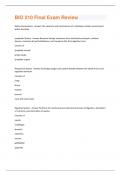
-
BIO 210 Final Exam Review Questions And Answers Rated A+ New Update Assured Satisfaction
- Exam (elaborations) • 21 pages • 2024
- Available in package deal
-
- $8.49
- + learn more
Define Homeostasis - Answer-The existence and maintenance of a relatively constant environment within the body. Lymphatic System - Answer-Removes foreign substances from the blood and lymph, combats disease, maintains tissue fluid balance, and transports fats from digestive tract. Consist of: lymphatic vessels lymph nodes lymphatic organs Respiratory System - Answer-Exchanges oxygen and carbon dioxide between the blood and air and regulates blood pH. Consists of: lungs larynx trache...

How much did you already spend on Stuvia? Imagine there are plenty more of you out there paying for study notes, but this time YOU are the seller. Ka-ching! Discover all about earning on Stuvia


